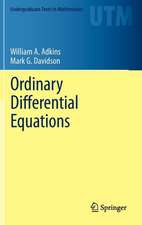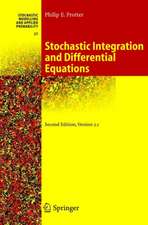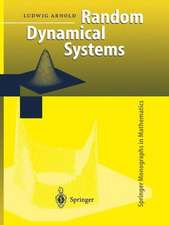A Course in Ordinary Differential Equations
Autor Stephen A. Wirkus, Randall J. Swiften Limba Engleză Paperback – 14 oct 2024
New to the Second Edition
- Moves the computer codes to Computer Labs at the end of each chapter, which gives professors flexibility in using the technology
- Covers linear systems in their entirety before addressing applications to nonlinear systems
- Incorporates the latest versions of MATLAB, Maple, and Mathematica
- Includes new sections on complex variables, the exponential response formula for solving nonhomogeneous equations, forced vibrations, and nondimensionalization
- Highlights new applications and modeling in many fields
- Presents exercise sets that progress in difficulty
- Contains color graphs to help students better understand crucial concepts in ODEs
- Provides updated and expanded projects in each chapter
| Toate formatele și edițiile | Preț | Express |
|---|---|---|
| Paperback (1) | 435.66 lei 6-8 săpt. | |
| CRC Press – 14 oct 2024 | 435.66 lei 6-8 săpt. | |
| Hardback (1) | 824.08 lei 6-8 săpt. | |
| CRC Press – 15 dec 2014 | 824.08 lei 6-8 săpt. |
Preț: 435.66 lei
Preț vechi: 548.44 lei
-21% Nou
Puncte Express: 653
Preț estimativ în valută:
83.38€ • 86.31$ • 70.47£
83.38€ • 86.31$ • 70.47£
Carte tipărită la comandă
Livrare economică 06-20 martie
Preluare comenzi: 021 569.72.76
Specificații
ISBN-13: 9781032917498
ISBN-10: 1032917490
Pagini: 808
Ilustrații: 180
Dimensiuni: 156 x 234 mm
Greutate: 1.49 kg
Ediția:2
Editura: CRC Press
Colecția Chapman and Hall/CRC
Locul publicării:Boca Raton, United States
ISBN-10: 1032917490
Pagini: 808
Ilustrații: 180
Dimensiuni: 156 x 234 mm
Greutate: 1.49 kg
Ediția:2
Editura: CRC Press
Colecția Chapman and Hall/CRC
Locul publicării:Boca Raton, United States
Public țintă
PostgraduateCuprins
Traditional First-Order Differential Equations. Geometrical and Numerical Methods for First-Order Equations. Elements of Higher-Order Linear Equations. Techniques of Nonhomogeneous Higher-Order Linear Equations. Fundamentals of Systems of Differential Equations. Laplace Transforms. Series Methods. Appendices. Answers. References. Index.
Notă biografică
Stephen A. Wirkus is an associate professor of mathematics at Arizona State University, where he has been a recipient of the Professor of the Year Award and NSF AGEP Mentor of the Year Award. He has published over 30 papers and technical reports. He completed his Ph.D. at Cornell University under the direction of Richard Rand.
Randall J. Swift is a professor of mathematics and statistics at California State Polytechnic University, Pomona, where he has been a recipient of the Ralph W. Ames Distinguished Research Award. He has authored more than 80 journal articles, three research monographs, and three textbooks. He completed his Ph.D. at the University of California, Riverside under the direction of M.M. Rao.
Randall J. Swift is a professor of mathematics and statistics at California State Polytechnic University, Pomona, where he has been a recipient of the Ralph W. Ames Distinguished Research Award. He has authored more than 80 journal articles, three research monographs, and three textbooks. He completed his Ph.D. at the University of California, Riverside under the direction of M.M. Rao.
Recenzii
Praise for the First Edition:
"A Course in Ordinary Differential Equations deserves to be on the MAA’s Basic Library List … the book with its layout, is very student friendly—it is easy to read and understand; every chapter and explanations flow smoothly and coherently … the reviewer would recommend this book highly for undergraduate introductory differential equation courses."
—Srabasti Dutta, College of Saint Elizabeth, MAA Online, July 2008
"An important feature is that the exposition is richly accompanied by computer algebra code (equally distributed between MATLAB, Mathematica, and Maple). The major part of the book is devoted to classical theory (both for systems and higher order equations). The necessary material from linear algebra is also covered. More advanced topics include numerical methods, stability of equilibria, bifurcations, Laplace transforms, and the power series method."
—EMS Newsletter, June 2007
"This is a delightful textbook for a standard one-semester undergraduate course in ordinary differential equations designed for students who had one year of calculus and continue their studies in engineering and mathematics. The main idea is to focus on the applications and methods of solutions, both analytical and numerical, with special attention paid to applications to real-world problems in engineering, physics, population dynamics, epidemiology, etc. A winning feature of the book is the extensive use of computer algebra codes throughout the text. Assuming that the students have no previous experience with Maple, MATLAB, or Mathematica, the authors present the relevant syntax and theory for all three programs. This helps students to understand better the theoretical material, use computer support more sensibly, and interpret results of computer simulation properly. Some background material from linear algebra is also provided throughout the text whenever necessary. … The book is nicely written, generously illustrated, and well structured. There are plenty of exercises ranging from drilling to challenging. Additional problems for revision and projects are collected at the end of each chapter. … An excellent blend of analytical and technical tools for studying ordinary differential equations, this text is a welcome addition to existing literature and is warmly recommended as essential reading for a first undergraduate course in differential equations."
—Zentralblatt MATH 1931
"A Course in Ordinary Differential Equations deserves to be on the MAA’s Basic Library List … the book with its layout, is very student friendly—it is easy to read and understand; every chapter and explanations flow smoothly and coherently … the reviewer would recommend this book highly for undergraduate introductory differential equation courses."
—Srabasti Dutta, College of Saint Elizabeth, MAA Online, July 2008
"An important feature is that the exposition is richly accompanied by computer algebra code (equally distributed between MATLAB, Mathematica, and Maple). The major part of the book is devoted to classical theory (both for systems and higher order equations). The necessary material from linear algebra is also covered. More advanced topics include numerical methods, stability of equilibria, bifurcations, Laplace transforms, and the power series method."
—EMS Newsletter, June 2007
"This is a delightful textbook for a standard one-semester undergraduate course in ordinary differential equations designed for students who had one year of calculus and continue their studies in engineering and mathematics. The main idea is to focus on the applications and methods of solutions, both analytical and numerical, with special attention paid to applications to real-world problems in engineering, physics, population dynamics, epidemiology, etc. A winning feature of the book is the extensive use of computer algebra codes throughout the text. Assuming that the students have no previous experience with Maple, MATLAB, or Mathematica, the authors present the relevant syntax and theory for all three programs. This helps students to understand better the theoretical material, use computer support more sensibly, and interpret results of computer simulation properly. Some background material from linear algebra is also provided throughout the text whenever necessary. … The book is nicely written, generously illustrated, and well structured. There are plenty of exercises ranging from drilling to challenging. Additional problems for revision and projects are collected at the end of each chapter. … An excellent blend of analytical and technical tools for studying ordinary differential equations, this text is a welcome addition to existing literature and is warmly recommended as essential reading for a first undergraduate course in differential equations."
—Zentralblatt MATH 1931
Descriere
This second edition presents analytical and numerical solution methods for typical engineering, physics, and mathematics applications. It uses the latest versions of MATLAB®, Maple™, and Mathematica® and moves the computer codes to Computer Labs at the end of each chapter. Along with new projects, exercises, and colo














